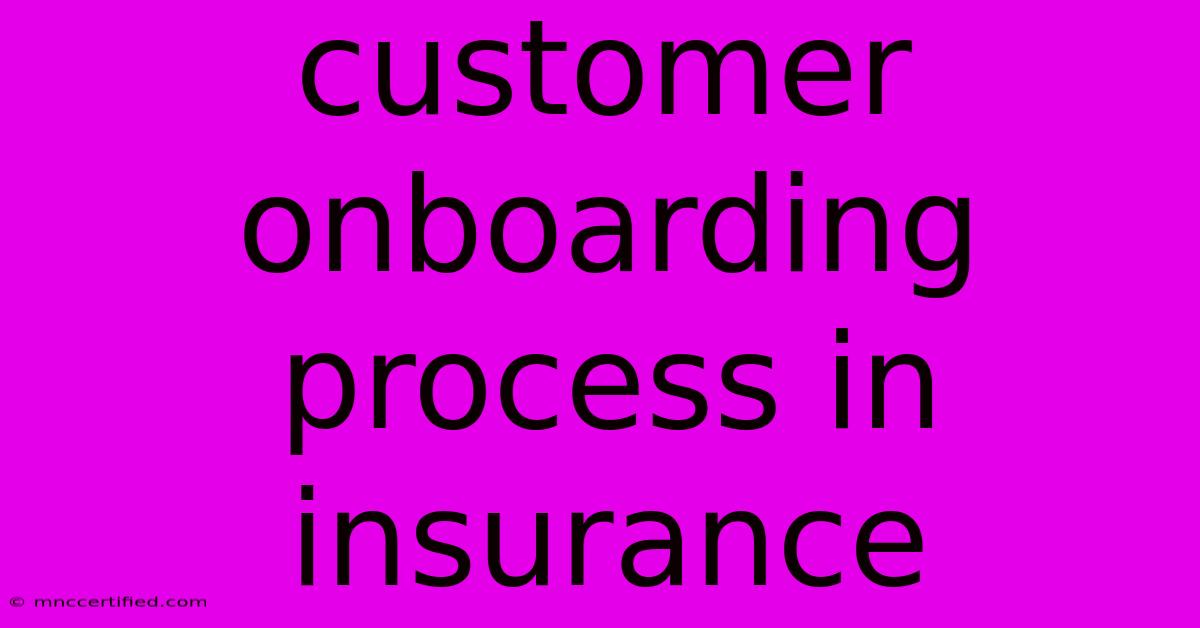Customer Onboarding Process In Insurance

Table of Contents
Streamline Your Customer Onboarding Process in Insurance: A Guide to Success
The insurance industry is increasingly competitive, with customer acquisition costs rising steadily. In this environment, winning new customers is only half the battle. Retaining them and building long-term relationships is crucial for sustained success. This is where a well-designed and implemented customer onboarding process comes into play.
Why is Customer Onboarding So Important in Insurance?
An effective onboarding process sets the stage for a positive and enduring customer relationship. Here's why it's essential in the insurance sector:
- Improved Customer Satisfaction: A smooth onboarding experience fosters positive initial perceptions, leading to higher customer satisfaction and loyalty.
- Reduced Churn: By providing clarity and support from the outset, you can minimize customer confusion and frustration, ultimately reducing churn rates.
- Increased Policy Adoption: A streamlined onboarding process encourages customers to fully understand and utilize their insurance policies, leading to greater value extraction.
- Enhanced Sales Opportunities: Onboarding is a prime opportunity to introduce additional products and services tailored to individual customer needs.
- Building Trust and Transparency: A clear and transparent onboarding process instills trust in your brand and fosters lasting relationships.
Key Elements of a Successful Customer Onboarding Process in Insurance
1. Personalized Welcome & Communication:
- Initial Contact: Start with a warm and personalized welcome email or call, acknowledging the customer's decision to choose your insurance services.
- Clear Communication: Provide concise and easy-to-understand information regarding the policy, coverage details, and any relevant documentation.
- Digital Onboarding: Utilize online platforms for efficient policy review, digital signatures, and secure document storage.
2. Data Collection and Verification:
- Essential Information: Collect all necessary customer data, such as personal details, contact information, policy specifics, and risk assessment data.
- Data Security: Implement robust data security protocols to protect customer information and comply with privacy regulations.
- Efficient Verification: Employ automated verification processes to streamline data validation and expedite the onboarding process.
3. Policy Explanation and Value Demonstration:
- Comprehensive Policy Review: Walk customers through their policy details, highlighting key coverage features and benefits.
- Personalized Guidance: Offer tailored explanations and answers to specific questions, ensuring complete understanding of the policy terms.
- Value Proposition: Clearly articulate the value and benefits of the chosen insurance plan, emphasizing its relevance to their needs and circumstances.
4. Digital Tools and Self-Service Options:
- Online Portal: Provide a secure online portal for customers to access policy information, manage claims, and make payments.
- Mobile App: Develop a user-friendly mobile app for seamless access to policy details, claims management, and communication with your team.
- Knowledge Base and FAQs: Offer comprehensive resources, FAQs, and online tutorials to address common customer inquiries and concerns.
5. Proactive Support and Follow-Up:
- Post-Onboarding Contact: Reach out to customers after the initial onboarding period to check for any questions or concerns.
- Feedback Collection: Actively seek feedback to identify areas for improvement and tailor the onboarding process further.
- Ongoing Engagement: Utilize email newsletters, targeted promotions, and personalized communication to keep customers informed and engaged.
Best Practices for Optimizing Your Customer Onboarding Process
- Keep it Simple and Straightforward: Eliminate unnecessary complexities and focus on clear communication.
- Go Digital: Embrace digital tools and platforms to streamline the process and enhance the customer experience.
- Personalize the Experience: Tailor your approach to individual customer needs and preferences.
- Focus on Value: Highlight the benefits and value of the chosen insurance plan.
- Provide Ongoing Support: Offer ongoing support through various channels to build trust and loyalty.
Tools and Technologies for Customer Onboarding Automation
- Customer Relationship Management (CRM) Software: Centralize customer data, manage interactions, and automate communication workflows.
- Document Automation Solutions: Simplify the creation and delivery of policy documents, reducing manual errors and processing time.
- Digital Signature Platforms: Enable secure and legally compliant electronic signatures for documents.
- Workflow Automation Tools: Streamline repetitive tasks and ensure seamless transitions between different stages of the onboarding process.
Conclusion
By implementing a robust and customer-centric onboarding process, you can significantly enhance the customer experience, build lasting relationships, and drive growth for your insurance business. Focus on personalization, digitalization, and ongoing support to create a welcoming and value-driven journey for your new customers.

Thank you for visiting our website wich cover about Customer Onboarding Process In Insurance. We hope the information provided has been useful to you. Feel free to contact us if you have any questions or need further assistance. See you next time and dont miss to bookmark.
Featured Posts
-
Are Atvs Covered By Homeowners Insurance
Nov 08, 2024
-
Porn Access Changes North Korean Military
Nov 08, 2024
-
Rotator Cuff Surgery Cost With Insurance
Nov 08, 2024
-
Tom Hanks Takes The Stage As A Comedian
Nov 08, 2024
-
Can Elections Fix Germanys Stalemate
Nov 08, 2024